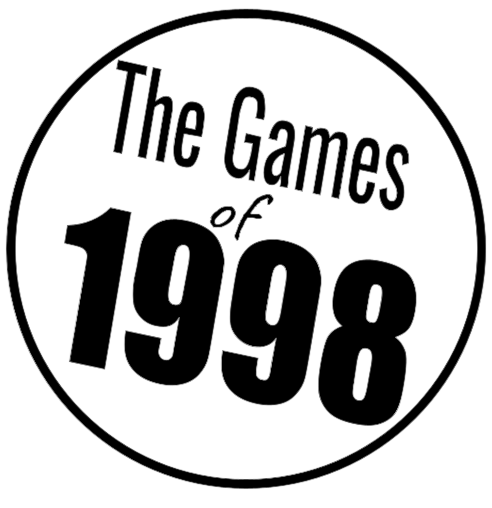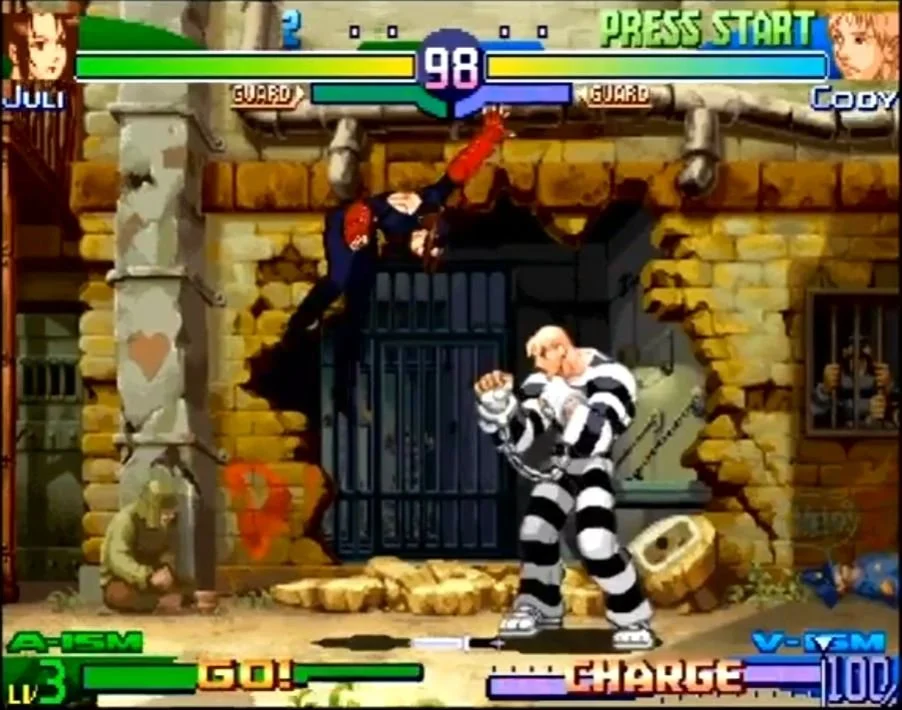Street Fighter Zero 3 (Street Fighter Alpha 3)
Release Date - June 29, 1998 (JP)
Developer - Capcom
Publisher - Capcom
Platform - Arcade (CP System II)
After the spectacular success of Street Fighter II: The World Warrior (1991) and its various revisions and follow ups (culminating in Super Street Fighter II: Turbo (1994)), the gaming world was eagerly awaiting a Street Fighter III. Somewhat surprisingly, this wouldn’t come to pass for several more years, instead Capcom decided to go back to the past with a prequel series!
Street Fighter Alpha: Warrior’s Dreams (or Street Fighter Zero in Japan) released in 1995, set between the events of Street Fighter (1987) and Street Fighter II.
Set before Street Fighter II you can see many of the cast have a younger look to reflect this.
(Screen taken from https://www.youtube.com/watch?v=Vg77EM0Acjs)
Street Fighter Alpha would feature younger versions of some of the familiar faces from Street Fighter II (notably Ryu, Ken and Chun Li), as well as returning characters from the original Street Fighter (see the British thug Birdie and muay thai master Adon), and even some original characters that had never been seen before (the Italian fortune teller Rose, and Air Force ace Charlie). This was also the first Street Fighter title to feature characters from Final Fight (1989) with the ninja Guy, and samurai wannabe Sodom filling out the cast.
The Alpha series would retain the same core gameplay elements and controls that made Street Fighter II a mega-hit with 6 attack buttons, special moves and even a return of the ‘super moves’ introduced in later Street Fighter II titles. Adding a new twist to the action, Street Fighter Alpha introduced some new mechanics like air-blocking (blocking while jumping), counter reversal moves and even a way to break your fall with a roll.
The graphics and animation were top-notch 2D for the time, and still look fantastic today. A consistent and striking art style helps tremendously.
(Screen taken from https://www.youtube.com/watch?v=Vg77EM0Acjs)
Taking advantage in advances in hardware and expertise with the CP System II board, the art style for Street Fighter Alpha was overhauled, and subsequently refined over the course of Street Fighter Alpha 2 (1996) and Street Fighter Alpha 3. The character sprites were more detailed than ever before, and an ‘anime’ style was introduced to the character’s portraits. The new graphics style is especially noticeable when comparing the cast that has returned from Street Fighter II. The detailed sprites are matched with equally lively animations, and the pre and post fight mannerisms from the characters are really impressive, it sometimes feels like watching a cartoon. The Alpha series overall is remembered fondly for some fantastic backgrounds and Street Fighter Alpha 3 is no exception; each stage is packed with detail and animation. Highlights include fighting outside a prison post-breakout, on stunning picturesque mediterranean islands and in front of a Shaolin temple (complete with a group of students practising their kung-fun in unison).
Cody, from Capcom’s Final Fight makes an appearance!
(Screenshot taken from https://www.youtube.com/watch?v=lLdWLqq7QnA)
The music in Street Fighter Alpha 3 was something of a departure compared to the previous Alpha games; a less melodic and more synthesised, industrial soundtrack is featured here. It lends the game its own unique feeling, and might have been influenced by the signature sounds of Street Fighter III: Fight for the Future (1997).
As the culmination of the Street Fighter Alpha series, Street Fighter Alpha 3 featured all eighteen characters from the first two games, alongside a further ten additional characters made up of returning fighters from Street Fighter and Street Fighter II, characters from Final Fight or totally original additions. Highlights include Cody, the main character from Capcom’s Final Fight series, Rainbow Mika (a female pro wrestler with some spectacular grappling moves and a penchant for hip attacks) and Karin, a rival to series favourite Sakura.
Two Street Fighter II characters face off. Each is using a different ‘-ism’ system, and have some new tricks up their sleeve.
(Screenshot taken from https://youtu.be/Vg77EM0Acjs)
In addition to new characters, Alpha 3 would introduce a unique feature to the Street Fighter gameplay; the ability to choose a play-style system. After choosing a character you then had the choice to choose either A-ism, X-ism or V-ism, and the choice would have a major effect on how your character plays! Each system works as per below;
A - Plays most similar to the other Alpha games, allowing air-blocking and up to 3 bars of ‘super meter’ that you can store and use with multiple super moves you could use.
X - Plays most similar to ‘Super Street Fighter II X’ (‘Turbo’ in the West). No air blocking and only one bar of ‘super meter’, but you did more damage per hit and only had one super move available.
V - The ‘Variable’ system, this mode means your character cannot perform super moves, but instead can perform ‘custom combos’ that were popular in Street Fighter Alpha 2.
Different ‘-ism’s allow for lots of variation in gameplay, even within the same character.
(Screenshot taken from https://www.youtube.com/watch?v=0aaigJ8Oikg)
This ‘-ism’ selection made the game feel like something of a mash-up of various Street Fighter titles, especially in conjunction with the massive cast that was available. It also meant that there were a lot of unique match-ups to explore as you had not only the roster but all the variants for each character. To this day, while there are definite favourites and preferred ‘-ism’s to use, creative players will surprise the community by utilising new combinations of characters and systems to unlock hidden potential.
Street Fighter Alpha 3 would go on to be ported to most home consoles of the era including Sega Saturn, PlayStation and Dreamcast. In more recent years, it has also been released multiple times in compilations across many consoles and on PC. In a testament to its popularity and unique mechanics amongst other Street Fighter games, it remains a popular title amongst competitive fighting game players decades after release.
Street Fighter Zero 3 remains a staple of the fighting game community, seeing regular play online and offline! 25 years after release!
Screenshot taken from (https://www.youtube.com/watch?v=vidN8x48llY)







